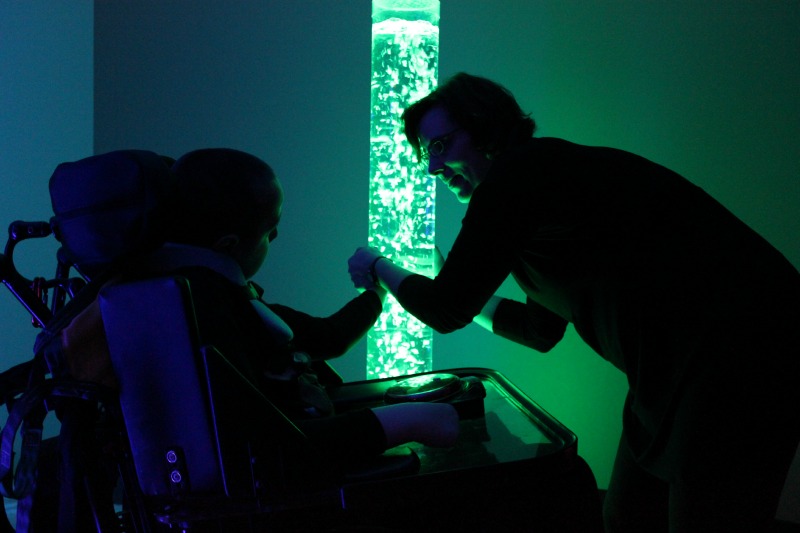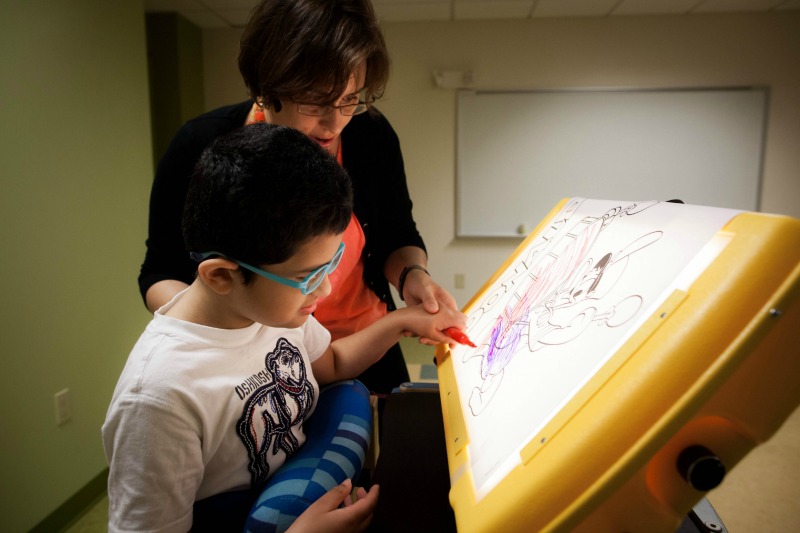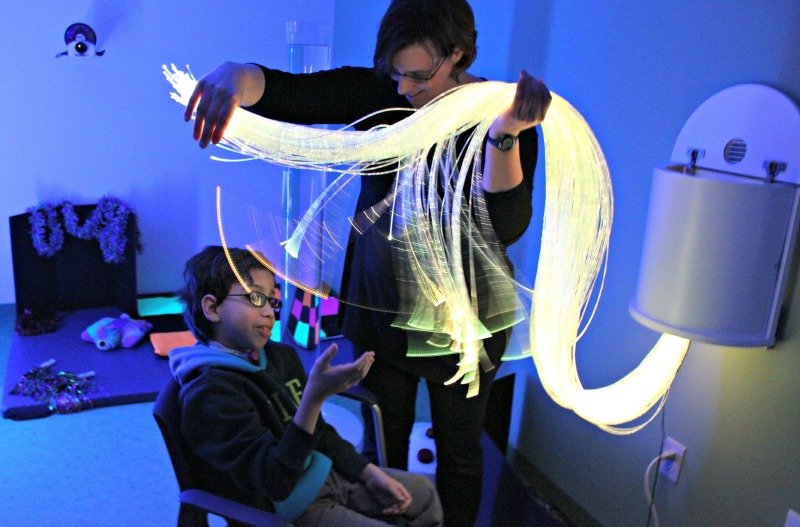Kennedy Day School Expands Vision Services
The Kennedy Day School, located onsite at Franciscan Hospital for Children, provides fully collaborative special education, therapeutic, and health services to students, ages 3 to 22, with significant, complex needs from more than 30 cities and towns across Massachusetts. If you have questions regarding the Kennedy Day School, please contact Lynne Goyuk at lgoyuk@fhfc.org or 617-779-1113.

If you were to walk into the Vision Center at the Kennedy Day School (KDS), the first thing you might notice would be the large glowing, bubbling tubes in the corner. Reminiscent of the ever popular lava lamp, KDS acquired the two large Bubble Tubes as a part of a new technology package funded to expand student services. These brightly-lit LED tubes rotate through a variety of colors, or stay static on the shade of your choice, with a constant stream of rising bubbles. Designed with multi-sensory environments in mind, the new Bubble Tubes help to enhance a calming and welcoming learning environment for Kennedy Day School students.
In the Kennedy Day School, the Vision Center is designed to engage students in activities that promote use of vision and multi-sensory strategies to acquire and process information within their environment. Vision Specialists, including Teachers of the Visually Impaired, provide assessment and direct instruction to students as well as training and consultation to the student’s educational team and family. The Center supports that unique and powerful intersection of sensory skills, communication and learning.
“The Vision Center allows students with a wide variety of visual impairments, including cortical visual impairment (CVI) access to equipment and materials that not only meet their visual needs, but are also fun,” says Bonnie Paulino, Director of the Kennedy Day School. “Light boxes, high contrast toys and materials, tactile books, bubble tubes and black-light materials are all used to engage students and promote learning.”

Some of the Vision Center’s furnishings are modeled after a Snoezelen Multi-Sensory Environment to provide a safe and non-threatening space for students with disabilities to enjoy mild stimulation of the visual, tactile, auditory and olfactory senses. Promoting independent discovery, the environment enables students to explore and relax while advancing their education and achieving their therapy goals. The Vision Center is also actively used by sensory motor groups, run by Occupational and Physical Therapists, as well as for individual therapy sessions and group class learning time.
“The calming sensory equipment creates an atmosphere in which students participate more actively in movement activities such as adapted Yoga. Our students are highly motivated by the multi-sensory equipment,” explains Asiya Baksh, Occupational Therapist at the Kennedy Day School. “We capitalize on each student’s unique interests to work on therapy goals, including reaching, grasping and functional tool use – like reaching for the switch controls on the bubble tube in order to change colors.”
As your eyes wander about the room, next to the Bubble Tubes you’ll see another intriguing piece of technology with long, thin, cascading, plastic fiber-optic tubes. The LED-lit Fiber Optic Spray is a hands-on experience for students, as the tubes themselves are easily and safely touched or laid across a student’s lap. The Spray can be used for visual and tactile stimulation, as well as color recognition. Similar to its neighboring Bubble Tube, the Fiber Optic Spray also contributes to a calming class environment.

“The Vision Center has provided several of our students with a much needed sensory/relaxation break that would be hard to duplicate in a busy classroom,” notes Pat Donovan, Assistive Technology Specialist at the Kennedy Day School. “One student in particular has shown carry-over of the calming effect of the Vision room to the rest of the day, showing increased cooperation and decreased agitation.”
Other technology additions include a Solar projector that slowly rotates images, creating a wall of color and movement in the KDS Vision Center. The projector and its images create different visual stimulation, moods and color throughout the room. A black light illuminates a corner of the classroom, along with complementary items like bright string and soft fabric pieces that stimulate both visual and tactile senses. The fun and flowing colors from a mirrored disco ball are also an added option to enhance the atmosphere, along with calming music that is often heard playing in the background.
“The addition of new technology and enhancements to the Vision Center allow teachers and therapists to further explore a variety of learning opportunities with their students,” says Linda Shanahan, Deaf-Blind Specialist and Service Coordinator. “These opportunities encompass color, light and movement, all of which can be powerful influences on a student’s overall level of engagement in learning.”
Are you curious about introducing your child to a multi-sensory environment? Check out the Sensory Room app in iTunes for a fun cause and effect activity that walks you through the different components of a sensory classroom!
View All Blog Stories